Popular categories
Looking for a yarn?

100% Wool
from 1.90 £ /50g
Order DROPS Needles & Hooks
Clicking the ORDER button will redirect you to Wool Warehouse Direct Ltd website
The yarn cost is calculated from the pattern’s smallest size and the yarn’s cheapest product type. Looking for an even better price? You might find it on the DROPS Deals!
Fudge Stripes
Knitted jumper in DROPS Alaska. The piece is worked top down with stocking stitch, European shoulders / diagonal shoulders, stripes and high neck. Sizes S - XXXL.
DROPS Design: Pattern x-480
Yarn group C or A + A
-------------------------------------------------------
SIZES:
S - M - L - XL - XXL - XXXL
MATERIALS:
DROPS ALASKA from Garnstudio (belongs to yarn group C)
650-700-750-850-950-1000 g colour 66, toffee
150-150-150-150-150-200 g colour 06, black
NEEDLES:
DROPS CIRCULAR NEEDLE SIZE 5.5 MM: Length 40 cm and 80 cm.
DROPS CIRCULAR NEEDLE SIZE 4.5 MM: Length 40 cm and 80 cm.
DROPS DOUBLE POINTED NEEDLES SIZE 5.5 MM.
DROPS DOUBLE POINTED NEEDLES SIZE 4.5 MM.
The technique MAGIC LOOP can be used – you then only need circular needle of 80 cm in each size.
KNITTING TENSION:
16 stitches in width and 20 rows in height with stocking stitch = 10 x 10 cm.
NOTE: Needle size is only a guide. If you get too many stitches on 10 cm, change to a larger needle size. If you get too few stitches on 10 cm, change to a smaller needle size.
-------------------------------------------------------
Alternative Yarn – See how to change yarns here
Yarn Groups A to F – Use the same pattern and change the yarn here
Yarn usage using an alternative yarn – Use our yarn converter here
-------------------------------------------------------

100% Wool
from 1.90 £ /50g
Order DROPS Needles & Hooks
Clicking the ORDER button will redirect you to Wool Warehouse Direct Ltd website
The yarn cost is calculated from the pattern’s smallest size and the yarn’s cheapest product type. Looking for an even better price? You might find it on the DROPS Deals!
- English (UK/cm)
- Česky
- Dansk
- Deutsch
- Eesti keel
- English (US/in)
- Español
- Français
- Íslenska
- Italiano
- Magyar
- Nederlands
- Norsk
- Polski
- Português
- Suomi
- Svenska
- English (UK/cm), Bulgaria
- English (UK/cm), Croatia
- English (UK/cm), Greece
- English (UK/cm), Latvia
- English (UK/cm), Lithuania
- English (UK/cm), Romania
- English (UK/cm), Slovenia
- Česky, Slovakia
Pattern instructions
EXPLANATIONS FOR THE PATTERN:
-------------------------------------------------------
RIDGE/GARTER STITCH (worked back and forth):
Knit all rows.
1 ridge = knit 2 rows.
INCREASE TIP FROM THE RIGHT SIDE:
Increase towards the left AFTER MARKER:
Use left needle to pick up thread between 2 stitches from row below, pick up thread from front and knit stitch in back loop.
Increase towards the right BEFORE MARKER:
Use left needle to pick up thread between 2 stitches from row below, pick up thread from behind and knit stitch in front loop.
INCREASE TIP FROM THE WRONG SIDE:
Increase towards the left AFTER MARKER:
Use left needle to pick up thread between 2 stitches from row below, pick up thread from behind and purl stitch in front loop.
Increase towards the right BEFORE MARKER:
Use left needle to pick up thread between 2 stitches from row below, pick up thread from front and purl stitch in back loop.
STRIPES BODY:
Work 4 rows/rounds with colour black, 12 rows/rounds with colour toffee. Repeat until you have worked 4 black stripes.
STRIPES SLEEVES:
Work 4 rows/rounds with colour black, 12 rows/rounds with colour toffee. Repeat until you have worked 5-5-5-5-4-4 black stripes.
DECREASE TIP (for sleeves):
Decrease 1 stitch on either side of the marker as follows: Work until there are 3 stitches left before the marker, knit 2 together, knit 2 (marker sits between these 2 stitches), slip 1 stitch as if to knit, knit 1 and pass the slipped stitch over the knitted stitch.
-------------------------------------------------------
START THE PIECE HERE:
-------------------------------------------------------
JUMPER – SHORT OVERVIEW OF THE PIECE:
The back piece is worked back and forth with circular needle, top down until the armholes are finished. Stitches are knitted up on each shoulder and increased for the neck, then the front piece is worked back and forth with circular needle and top down until the armholes are finished.
The front and back pieces are joined and the body continued in the round. Stitches are knitted up around the armholes, the sleeve-cap is worked back and forth then the rest of the sleeve is worked in the round with short circular needle/double pointed needles. The neck is worked in the round to finish.
BACK PIECE:
Cast on 28-28-32-34-34-36 stitches with circular needle size 5.5 mm and DROPS Alaska.
Purl 1 row from the wrong side.
Insert 1 marker inside 3 stitches on each side. Markers should sit inside these 3 stitches on every row onwards.
Work stocking stitch back and forth.
AT THE SAME TIME increase AFTER the marker at the beginning of the first row from the right side) and BEFORE the marker at the end of the row – read INCREASE TIP FROM THE RIGHT SIDE.
On the next row (wrong side) increase in the same way – read INCREASE TIP FROM THE WRONG SIDE.
Increase from both the right and wrong side a total of 28-30-30-32-34-36 times. After the last increase there are 84-88-92-98-102-108 stitches.
The piece is measured from here!
Continue with stocking stitch until the piece measures 10-11-12-13-14-14 cm (measured outermost along the armhole). Now work STRIPES BODY – read description above. Continue working until the piece measures 15-16-17-18-19-19 cm. Cut the yarn, put stitches on a thread or an extra needle and work the front piece.
FRONT PIECE:
Start on the left shoulder (when the garment is worn).
Knit up 28-30-30-32-34-36 stitches inside the outermost stitch along the shoulder on back piece (i.e. knit up 1 stitch in each row from the top of the back piece). Work stocking stitch back and forth for 4 cm. Increase stitches for the neck at the beginning of each row from the right side, increase after the 3 first stitches, remember INCREASE FROM THE RIGHT SIDE. Increase 1 stitch a total of 4 times = 32-34-34-36-38-40 stitches. Purl 1 row from the wrong side. Cut the yarn and put stitches on a thread or an extra needle and work the right shoulder.
Knit up 28-30-30-32-34-36 stitches inside the outermost stitch along the right back shoulder. Work stocking stitch back and forth for 4 cm. Increase stitches for the neck, at the end of each row from the right side, increase before the last 3 stitches, remember INCREASE TIP FROM THE RIGHT SIDE. Increase 1 stitch a total of 4 times = 32-34-34-36-38-40 stitches. Purl 1 row from the wrong side after the last increase.
Work the next row from the right side as follows: Knit the 32-34-34-36-38-40 stitches from the right front piece, cast on 20-20-24-26-26-28 stitches for the neck at the end of the row, knit the 32-34-34-36-38-40 stitches from the left front piece = 84-88-92-98-102-108 stitches. The piece is measured from here!
Continue with stocking stitch back and forth until the piece measures 18-19-20-21-22-24 cm (measured outermost along the armhole). Work STRIPES BODY – read description above. Continue until the piece measures 23-24-25-26-27-29 cm. Now join the front and back pieces for the body:
BODY:
Work stocking stitch over the 84-88-92-98-102-108 stitches from the front piece, cast on 2-4-10-10-14-16 new stitches at the end of the row (= side), work the 84-88-92-98-102-108 stitches from the back piece, cast on 2-4-10-10-14-16 stitches at the end of the row = 172-184-204-216-232-248 stitches.
Work stocking stitch and stripes in the round until the piece measures 48-50-52-54-56-58 cm measured from the top of the shoulder on the front piece. Now divide the front and back piece for the split in each side. Place the 86-92-102-108-116-124 stitches from the front piece on a thread or extra needle and work the back piece.
BACK PIECE:
Change to circular needle size 4.5 mm. Knit 1 row from the right side and increase 12-14-12-14-14-18 stitches evenly spaced = 98-106-114-122-130-142 stitches. Work as follows from the wrong side: 2 edge stitches in GARTER STITCH – read description above, * purl 2, knit 2 *, work from *-* until there are 4 stitches left, purl 2 and 2 edge stitches in garter stitch. Continue this rib for 8 cm. Cast off.
FRONT PIECE:
Place the stitches on circular needle size 4.5 mm and work in the same way as the back piece.
LEFT SLEEVE:
Using circular needle size 5.5 mm and DROPS Alaska, knit up from the right side 36-38-41-41-44-46 stitches from the bottom of the armhole and up the front piece, then 24-26-27-29-30-30 stitches from the shoulder, down the back piece to the bottom of the armhole = 60-64-68-70-74-76 stitches. Insert 1 marker in the middle of the row – the sleeve is measured from this marker.
Work stocking stitch back and forth for 1-1-3-3-4-5 cm.
Now join the sleeve using circular needle/double pointed needles size 5.5 mm. Insert 1 marker at the beginning of the round (mid-under sleeve). Allow the marker to follow your work onwards.
Start at the marker and work stocking stitch in the round until the sleeve measures 3-3-5-5-6-7 cm, now decrease 2 stitches mid-under the sleeve – read DECREASE TIP.
Decrease like this every 4-3½-3-3-2½-2½ cm a total of 8-9-10-10-11-11 times = 44-46-48-50-52-54 stitches. AT THE SAME TIME when the sleeve measures 4-4-6-6-7-8 cm, work STRIPES SLEEVES – read description above.
Continue working until the sleeve measures 37-37-36-36-35-35 cm from the marker. There is 8 cm left. Try the jumper on and work to desired length. Knit 1 round and increase 8-6-8-6-8-6 stitches evenly spaced = 52-52-56-56-60-60 stitches. Change to double pointed needles size 4.5 mm. Work rib (knit 2, purl 2) for 8 cm. Cast off a little loosely. The sleeve measures approx. 45-45-44-44-43-43 cm from the marker.
RIGHT SLEEVE:
Work the same way as left sleeve but knit up 24-26-27-29-30-30 stitches from the bottom of the armhole up the back piece and 36-38-41-41-44-46 stitches from the shoulder down the front piece to the bottom of the armhole. Sew the bottom of the armhole together – see sketch.
NECK:
Start on one shoulder and knit up from the right side, inside the 1 edge stitch, 88 to 108 stitches using short circular needle size 4.5 mm. The stitch-number should be divisible by 4. Work rib in the round (knit 2, purl 2) for 14 cm. Cast off a little loosely. The neck can be folded double to the inside.
Diagram

|
= Sew the bottom of the armhole together: Sew b to B |
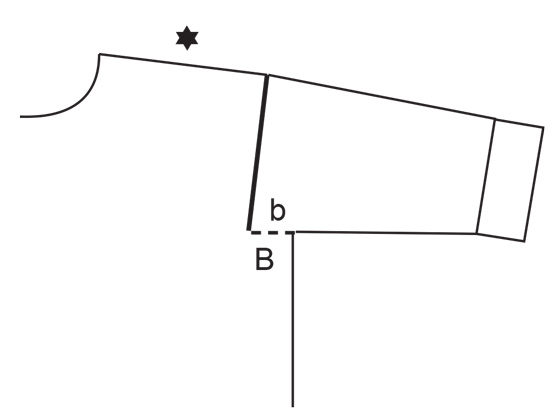

What can you do with our patterns? You can share DROPS patterns online, using the pattern original picture, materials, name and number. But you are NOT ALLOWED to reproduce the complete pattern digitally in any way. Yarn stores are welcome to use the DROPS pattern database to promote the sale of our assortment. You can print out our patterns, make as many copies as you’d like. The only thing we ask is that you don't make any changes / additions to the original printed document. And that the patterns according to the DROPS philosophy are given out to the consumers for free. Editorials that wish to publish our patterns in printed books or magazines can contact us for more information. The sale of garments based on DROPS patterns is permitted as long as they are sold as single items or per order. Further commercial use of the patterns is not permitted. It has to be clearly stated that the garment is made based on a design from DROPS DESIGN. The use of clothing labels of which DROPS DESIGN forms part is conditioned by the inclusion of the following text: “A DROPS DESIGN made by …..”. The use of DROPS photos for marketing purposes/sales is only permitted in connection with the use/sale of DROPS products. The photos may not be cut or edited and the logo should be clearly visible.
We reserve the right to withdraw the permission for use of our patterns at any time, notwithstanding the reason.
Each of our patterns has specific tutorial videos to help you.
These step-by-step tutorials might also help you:
Why is the knitting/crochet tension so important?
Knitting tension is what determines the final measurements of your work, and is usually measured per 10 x 10 cm. It is provided like so: number of stitches in width x number of rows in height - eg: 19 stitches x 26 rows = 10 x 10 cm.
The knitting tension is very individual; some people knit/crochet loosely while others work tightly. You adjust the knitting tension with the needle size, which is why the suggested needle size is only meant as a guide! You need to adjust this (up or down) to ensure that YOUR knitting tension matches the knitting tension provided in the pattern. If you work with a different knitting tension than provided you will have a different yarn consumption, and your work will have different measurements than what the pattern suggests.
The knitting tension also determines which yarns can replace each other. As long as you achieve the same knitting tension you can replace one yarn with another.
See DROPS lesson: How to measure your tension/gauge
See DROPS video: How to make a gauge tension swatch
How do I know how many balls of yarn I need?
The required amount of yarn is provided in grams, eg: 450 g. To calculate how many balls you’ll need you first need to know how many grams are in 1 ball (25g, 50g or 100g). This information is available if you click on the individual yarn quality on our pages. Divide the amount required with the amount of each ball. For example, if each ball is 50g (the most common amount), the calculation will be as follows: 450 / 50 = 9 balls.
Can I use a different yarn than what the pattern suggests?
The important thing when changing from one yarn to another is that the knitting/crochet tension remains the same. This is so that the measurements of the finished piece will be the same as on the sketch provided. It is easier to achieve the same knitting tension using yarns from the same yarn group. It is also possible to work with multiple strands of a thinner yarn to achieve the knitting tension of a thicker one. Please try our yarn converter. We recommend you to always work a test swatch.
Please NOTE: when changing yarn the garment might have a different look and feel to the garment in the photo, due to individual properties and qualities of each yarn.
See DROPS lesson: Can I use a different yarn than the one mentioned in the pattern?
What are the yarn groups?
All our yarns are categorised into yarn groups (from A to F) according to thickness and knitting tension – group A contains the thinnest yarns and group F the thickest. This makes it easier for you to find alternative yarns to our patterns, should you wish to switch yarn. All yarns within the same group have a similar knitting tension and can easily replace each other. However, different yarn qualities have different structures and properties which will give the finished work a unique look and feel.
How do I use the yarn calculator?
At the top of all our patterns you’ll find a link to our yarn calculator, which is a helpful tool should you wish to use a different yarn than suggested. By filling in the yarn quality you wish to replace, the amount (in your size) and number of strands, the calculator will present good alternative yarns with the same knitting tension. Additionally it will tell you how much you’ll require in the new qualities and whether you’ll need to work with multiple strands. Most skeins are 50g (some are 25g or 100g).
If the pattern is worked with multiple colours, every colour will have to be calculated separately. Similarly, if the pattern is worked with several strands of different yarns (for example 1 strand Alpaca and 1 strand Kid-Silk) you will have to find alternatives for each, individually.
Why do you show discontinued yarns in the patterns?
Since different yarns have different qualities and textures we have chosen to keep the original yarn in our patterns. However, you can easily find options among our available qualities by using our yarn calculator, or simply pick a yarn from the same yarn group.
It is possible that some retailers still have discontinued yarns in stock, or that someone has a few skeins at home that they would like to find patterns for.
The yarn calculator will provide both alternative yarn as well as required amount in the new quality.
What size should I knit?
If you think it's hard to decide what size to make, it can be a good idea to measure a garment you own already and like the size of. Then you can pick the size by comparing those measures with the ones available in the pattern's size chart.
You'll find the size chart at the bottom of the pattern.
See DROPS lesson: How to read size chart
Why do I get the wrong knitting tension with the suggested needle size?
The needle size provided in the pattern serves only as a guide, the important thing is to follow the knitting tension. And since knitting tension is very individual, you will have to adjust the needle size to ensure that YOUR tension is the same as in the pattern – maybe you’ll have to adjust 1, or even 2 needle sizes, up or down to achieve the correct tension. For this, we recommend that you work test swatches.
Should you work with a different knitting tension than the one provided, the measurements of the finished garment might deviate from the measurement sketch.
See DROPS lesson: How to measure your tension/gauge
See DROPS video: How to make a tension/gauge swatch
Why is the pattern worked top-down?
Working a garment top-down provides more flexibility and room for personal adjustment. For example it is easier to try the garment on while working, as well as making adjustments to length of yoke and shoulder caps.
The instructions are carefully explaining every step, in the correct order. Diagrams are adjusted to the knitting direction and are worked as usual.
How do I work according to a knitting diagram?
The diagram depicts all rows/rounds, and every stitch seen from the right side. It is read from bottom to top, from right to left. 1 square = 1 stitch.
When working back and forth, every other row is worked from the right side and every other row is worked from the wrong side. When working from the wrong side, the diagram will have to be worked reversed: from left to right, knit stitches are purled, purl stitches are knit etc.
When working in the round every round is worked from the right side and the diagram are worked from right to left on all rounds.
See DROPS lesson: How to read knitting diagrams
How do I work according to a crochet diagram?
The diagram depicts all rows/rounds, and every stitch seen from the right side. It is worked from bottom to top, from right to left.
When working back and forth every other row is worked from the right side: from right to left and every other row is worked from the wrong side: from left to right.
When working in the round, every row in the diagram are worked from the right side, from right to left.
When working a circular diagram you start in the middle and work your way outwards, counter clockwise, row by row.
The rows usually start with a given number of chain stitches (equivalent to the height of the following stitch), this will either be depicted in the diagram or explained in the pattern.
See DROPS lesson: How to read crochet diagrams
How do I work several diagrams simultaneously on the same row/round?
Instructions for working several diagrams after each other on the same row/round, will often be written like so: “work A.1, A.2, A.3 a total of 0-0-2-3-4 times". This means you work A.1 once, then A.2 is worked once, and A.3 is repeated (in width) the number of times provided for your size – in this case like so: S = 0 times, M = 0 times, L=2 times, XL= 3 times and XXL = 4 times.
The diagrams are worked as usual: begin with the first row in A.1, then work the first row in A.2 etc.
See DROPS lesson: How to read knitting diagrams
See DROPS lesson: How to read crochet diagrams
Why are the sleeves shorter in larger sizes?
The total width of the garment (from wrist-to-wrist) will be larger in the larger sizes, despite the actual sleeves being shorter. The larger sizes have longer sleeve caps and wider shoulders, so there will be a good fit in all sizes.
Where on the garment is the length measured?
The measurement sketch/schematic drawing provides information regarding the full length of the garment. If it’s a jumper or a jacket the length is measured from the highest point on the shoulder closest to the neckline, and straight down to the bottom of the garment. It is NOT measured from the tip of shoulder. Similarly, the length of yoke is measured from the highest point on the shoulder and down to where yoke is split into body and sleeves.
On a jacket measures are never taken along bands, unless specifically stated. Always measure inside band stitches when measuring the length.
See DROPS lesson: How to read a schematic drawing
What is a repeat?
Diagrams are often repeated on the round or in height. 1 repeat is the diagram the way it appears in the pattern. If it says to work 5 repeats of A.1 in the round, then you work A.1 a total of 5 times after/next to each other in the round. If it says to work 2 repeats of A.1 vertically/in height you work the entire diagram once, then begin again at the start and work the entire diagram one more time.
Why does the piece start with more chain stitches than it’s worked with?
Chain stitches are slightly narrower than other stitches and to avoid working the cast-on edge too tight, we simply chain more stitches to begin with. The stitch count will be adjusted on the following row to fit the pattern and measurement sketch.
Why increase before the rib edge when the piece is worked top-down?
The rib edge is more elastic and will contract slightly compared to, for example, stocking stitch. By increasing before the rib edge, you avoid a visible difference in width between the rib edge and the rest of the body.
Why increase in the cast-off edge?
It’s very easy to cast off too tightly, and by making yarn overs while casting off (and simultaneously casting these off) you avoid a too tight cast off edge.
See DROPS video: How to bind off with yarn overs (yo)
How do I increase/decrease on every 3rd and 4th row/round alternately?
To achieve an even increase (or decrease) you can increase on, for example: every 3rd and 4th row alternately, like so: work 2 rows and increase on the 3rd row, work 3 rows and increase on the 4th. Repeat this until the increase is complete.
See DROPS lesson: Increase or decrease 1 st on every 3rd and 4th row alternately
How can I work a jacket in the round instead of back and forth?
Should you prefer to work in the round instead of back and forth, you may of course adjust the pattern. You’ll need to add steeks mid-front (usually 5 stitches), and follow the instructions. When you would normally turn and work from the wrong side, simply work across the steek and continue in the round. At the end you’ll cut the piece open, pick up stitches to work bands, and cover the cut edges.
See DROPS video: How to knit steeks and cut open
Can I work a jumper back and forth instead of in the round?
Should you prefer to work back and forth instead of in the round, you may of course adjust the pattern so you work the pieces separately and then assemble them at the end. Divide the stitches for the body in 2, add 1 edge stitch in each side (for sewing) and work the front and back pieces separately.
See DROPS lesson: Can I adapt a pattern for circular needles into straight needles?
Why is the pattern slightly different than what I see in the photo?
Pattern repeats can vary slightly in the different sizes, in order to get the correct proportions. If you’re not working the exact same size as the garment in the photo, yours might deviate slightly. This has been carefully developed and adjusted so that the complete impression of the garment is the same in all sizes.
Make sure to follow instructions and diagrams for your size!
How do I make a women’s size garment into a men’s size one?
If you have found a pattern you like which is available in women’s size it’s not very difficult to convert it to men’s size. The biggest difference will be the length of sleeves and body. Start working on the women size that you think would fit across the chest. The additional length will be worked right before you cast off for the armhole/sleeve cap. If the pattern is worked top-down you can add the length right after the armhole or before the first decrease on sleeve.
Regarding additional yarn amount, this will depend on how much length you add, but it is better with a skein too many than too few.
How do I prevent a hairy garment from shedding?
All yarns will have excess fibres (from production) that might come off as lint or shedding. Brushed yarns (ie hairier yarns) have more of these loose, excess fibres, causing more shedding.
Shedding also depends on what is worn under or over the garment, and whether this pulls at the yarn fibres. It’s therefore not possible to guarantee that there will be no shedding
Below are some tips on how to get the best result when working with hairier yarns:
1. When the garment is finished (before you wash it) shake it vigorously so the looser hairs come off. NOTE: do NOT use a lint roller, brush or any method that pulls at the yarn.
2. Place the garment in a plastic bag and put it in your freezer - the temperature will cause the fibres to become less attached to each other, and excess fibres will come off easier.
3. Leave in the freezer for a few hours before taking it out and shaking it again.
4. Wash the garment according to the instructions on the yarn label.
Why does my garment pill?
Pilling is a natural process that happens to even the most exclusive of fibers. It's a natural sign of wear and tear that is hard to avoid, and that is most visible in high friction areas of your garment like a sweater's arms and cuffs.
You can make your garment look as new by removing the pilling, using a fabric comb or a pill/lint remover.
In the meantime, you can read the questions and answers that others have left to this pattern or join the DROPS Workshop on Facebook to get help from fellow knitters/crocheters!
You might also like...
Fudge Stripes
Fudge Stripes
Fudge Stripes
Fudge Stripes
Fudge Stripes |
||||
 |
 |
|||
Knitted jumper in DROPS Alaska. The piece is worked top down with stocking stitch, European shoulders / diagonal shoulders, stripes and high neck. Sizes S - XXXL.
DROPS 237-16 |
||||
|
------------------------------------------------------- EXPLANATIONS FOR THE PATTERN: ------------------------------------------------------- RIDGE/GARTER STITCH (worked back and forth): Knit all rows. 1 ridge = knit 2 rows. INCREASE TIP FROM THE RIGHT SIDE: Increase towards the left AFTER MARKER: Use left needle to pick up thread between 2 stitches from row below, pick up thread from front and knit stitch in back loop. Increase towards the right BEFORE MARKER: Use left needle to pick up thread between 2 stitches from row below, pick up thread from behind and knit stitch in front loop. INCREASE TIP FROM THE WRONG SIDE: Increase towards the left AFTER MARKER: Use left needle to pick up thread between 2 stitches from row below, pick up thread from behind and purl stitch in front loop. Increase towards the right BEFORE MARKER: Use left needle to pick up thread between 2 stitches from row below, pick up thread from front and purl stitch in back loop. STRIPES BODY: Work 4 rows/rounds with colour black, 12 rows/rounds with colour toffee. Repeat until you have worked 4 black stripes. STRIPES SLEEVES: Work 4 rows/rounds with colour black, 12 rows/rounds with colour toffee. Repeat until you have worked 5-5-5-5-4-4 black stripes. DECREASE TIP (for sleeves): Decrease 1 stitch on either side of the marker as follows: Work until there are 3 stitches left before the marker, knit 2 together, knit 2 (marker sits between these 2 stitches), slip 1 stitch as if to knit, knit 1 and pass the slipped stitch over the knitted stitch. ------------------------------------------------------- START THE PIECE HERE: ------------------------------------------------------- JUMPER – SHORT OVERVIEW OF THE PIECE: The back piece is worked back and forth with circular needle, top down until the armholes are finished. Stitches are knitted up on each shoulder and increased for the neck, then the front piece is worked back and forth with circular needle and top down until the armholes are finished. The front and back pieces are joined and the body continued in the round. Stitches are knitted up around the armholes, the sleeve-cap is worked back and forth then the rest of the sleeve is worked in the round with short circular needle/double pointed needles. The neck is worked in the round to finish. BACK PIECE: Cast on 28-28-32-34-34-36 stitches with circular needle size 5.5 mm and DROPS Alaska. Purl 1 row from the wrong side. Insert 1 marker inside 3 stitches on each side. Markers should sit inside these 3 stitches on every row onwards. Work stocking stitch back and forth. AT THE SAME TIME increase AFTER the marker at the beginning of the first row from the right side) and BEFORE the marker at the end of the row – read INCREASE TIP FROM THE RIGHT SIDE. On the next row (wrong side) increase in the same way – read INCREASE TIP FROM THE WRONG SIDE. Increase from both the right and wrong side a total of 28-30-30-32-34-36 times. After the last increase there are 84-88-92-98-102-108 stitches. The piece is measured from here! Continue with stocking stitch until the piece measures 10-11-12-13-14-14 cm (measured outermost along the armhole). Now work STRIPES BODY – read description above. Continue working until the piece measures 15-16-17-18-19-19 cm. Cut the yarn, put stitches on a thread or an extra needle and work the front piece. FRONT PIECE: Start on the left shoulder (when the garment is worn). Knit up 28-30-30-32-34-36 stitches inside the outermost stitch along the shoulder on back piece (i.e. knit up 1 stitch in each row from the top of the back piece). Work stocking stitch back and forth for 4 cm. Increase stitches for the neck at the beginning of each row from the right side, increase after the 3 first stitches, remember INCREASE FROM THE RIGHT SIDE. Increase 1 stitch a total of 4 times = 32-34-34-36-38-40 stitches. Purl 1 row from the wrong side. Cut the yarn and put stitches on a thread or an extra needle and work the right shoulder. Knit up 28-30-30-32-34-36 stitches inside the outermost stitch along the right back shoulder. Work stocking stitch back and forth for 4 cm. Increase stitches for the neck, at the end of each row from the right side, increase before the last 3 stitches, remember INCREASE TIP FROM THE RIGHT SIDE. Increase 1 stitch a total of 4 times = 32-34-34-36-38-40 stitches. Purl 1 row from the wrong side after the last increase. Work the next row from the right side as follows: Knit the 32-34-34-36-38-40 stitches from the right front piece, cast on 20-20-24-26-26-28 stitches for the neck at the end of the row, knit the 32-34-34-36-38-40 stitches from the left front piece = 84-88-92-98-102-108 stitches. The piece is measured from here! Continue with stocking stitch back and forth until the piece measures 18-19-20-21-22-24 cm (measured outermost along the armhole). Work STRIPES BODY – read description above. Continue until the piece measures 23-24-25-26-27-29 cm. Now join the front and back pieces for the body: BODY: Work stocking stitch over the 84-88-92-98-102-108 stitches from the front piece, cast on 2-4-10-10-14-16 new stitches at the end of the row (= side), work the 84-88-92-98-102-108 stitches from the back piece, cast on 2-4-10-10-14-16 stitches at the end of the row = 172-184-204-216-232-248 stitches. Work stocking stitch and stripes in the round until the piece measures 48-50-52-54-56-58 cm measured from the top of the shoulder on the front piece. Now divide the front and back piece for the split in each side. Place the 86-92-102-108-116-124 stitches from the front piece on a thread or extra needle and work the back piece. BACK PIECE: Change to circular needle size 4.5 mm. Knit 1 row from the right side and increase 12-14-12-14-14-18 stitches evenly spaced = 98-106-114-122-130-142 stitches. Work as follows from the wrong side: 2 edge stitches in GARTER STITCH – read description above, * purl 2, knit 2 *, work from *-* until there are 4 stitches left, purl 2 and 2 edge stitches in garter stitch. Continue this rib for 8 cm. Cast off. FRONT PIECE: Place the stitches on circular needle size 4.5 mm and work in the same way as the back piece. LEFT SLEEVE: Using circular needle size 5.5 mm and DROPS Alaska, knit up from the right side 36-38-41-41-44-46 stitches from the bottom of the armhole and up the front piece, then 24-26-27-29-30-30 stitches from the shoulder, down the back piece to the bottom of the armhole = 60-64-68-70-74-76 stitches. Insert 1 marker in the middle of the row – the sleeve is measured from this marker. Work stocking stitch back and forth for 1-1-3-3-4-5 cm. Now join the sleeve using circular needle/double pointed needles size 5.5 mm. Insert 1 marker at the beginning of the round (mid-under sleeve). Allow the marker to follow your work onwards. Start at the marker and work stocking stitch in the round until the sleeve measures 3-3-5-5-6-7 cm, now decrease 2 stitches mid-under the sleeve – read DECREASE TIP. Decrease like this every 4-3½-3-3-2½-2½ cm a total of 8-9-10-10-11-11 times = 44-46-48-50-52-54 stitches. AT THE SAME TIME when the sleeve measures 4-4-6-6-7-8 cm, work STRIPES SLEEVES – read description above. Continue working until the sleeve measures 37-37-36-36-35-35 cm from the marker. There is 8 cm left. Try the jumper on and work to desired length. Knit 1 round and increase 8-6-8-6-8-6 stitches evenly spaced = 52-52-56-56-60-60 stitches. Change to double pointed needles size 4.5 mm. Work rib (knit 2, purl 2) for 8 cm. Cast off a little loosely. The sleeve measures approx. 45-45-44-44-43-43 cm from the marker. RIGHT SLEEVE: Work the same way as left sleeve but knit up 24-26-27-29-30-30 stitches from the bottom of the armhole up the back piece and 36-38-41-41-44-46 stitches from the shoulder down the front piece to the bottom of the armhole. Sew the bottom of the armhole together – see sketch. NECK: Start on one shoulder and knit up from the right side, inside the 1 edge stitch, 88 to 108 stitches using short circular needle size 4.5 mm. The stitch-number should be divisible by 4. Work rib in the round (knit 2, purl 2) for 14 cm. Cast off a little loosely. The neck can be folded double to the inside. |
||||
Diagram explanations |
||||
|
||||

|
||||

|
||||
|
Have you made this or any other of our designs? Tag your pictures in social media with #dropsdesign so we can see them! Do you need help with this pattern?You'll find tutorial videos, a Comments/Questions area and more by visiting the pattern on garnstudio.com. © 1982-2024 DROPS Design A/S. We reserve all rights. This document, including all its sub-sections, has copyrights. Read more about what you can do with our patterns at the bottom of each pattern on our site. |
||||
With over 40 years in knitting and crochet design, DROPS Design offers one of the most extensive collections of free patterns on the internet - translated to 17 languages. As of today we count 304 catalogues and 11422 patterns - 11422 of which are translated into English (UK/cm).
We work hard to bring you the best knitting and crochet have to offer, inspiration and advice as well as great quality yarns at incredible prices! Would you like to use our patterns for other than personal use? You can read what you are allowed to do in the Copyright text at the bottom of all our patterns. Happy crafting!








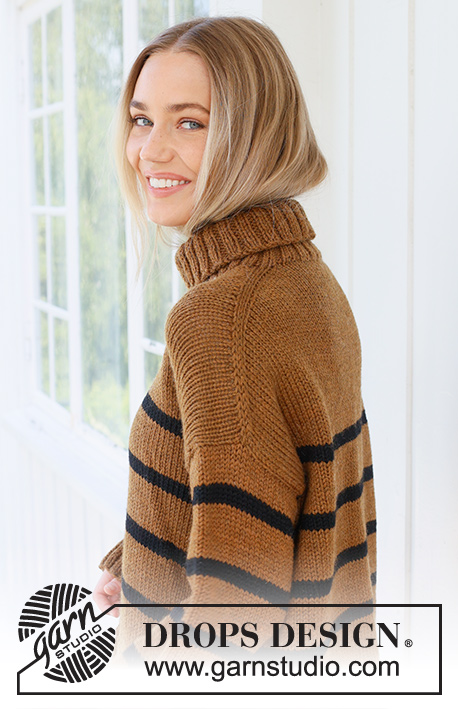

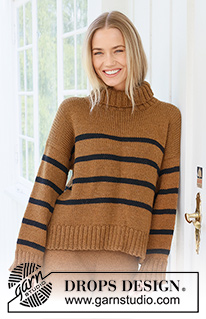

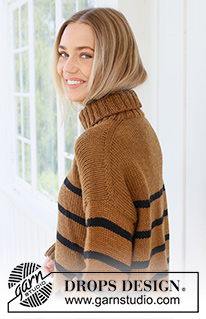




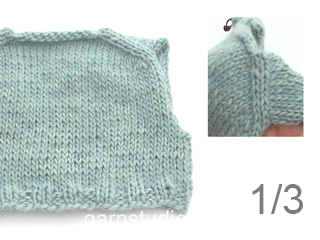
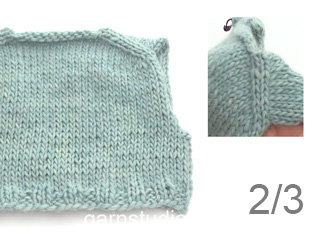
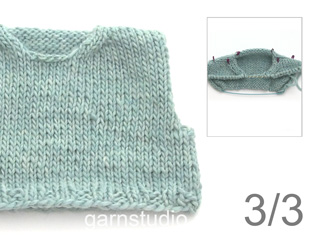


















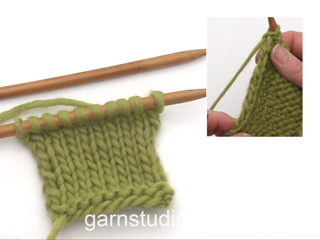











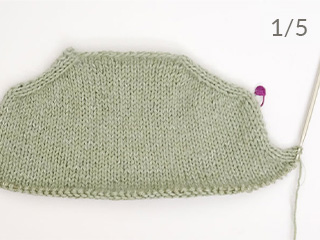
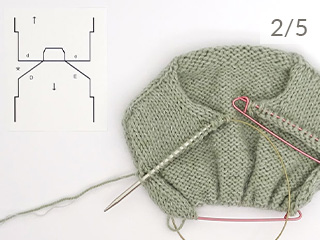
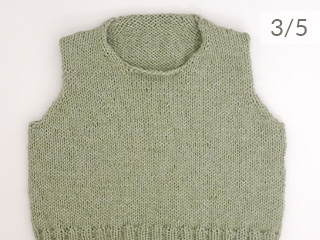

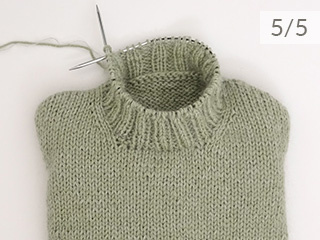






















Comments / Questions (28)
Hello, I am knitting size M and the length of the torso reaches 50 cm immediately after the end of the 4th strip, so should I start knitting the elastic pattern straight away, although in the accompanying photo it is followed by a part of the stockinette jersey? I would also like to ask how to measure the armholes, it comes out to me at 24 cm instead of 20 cm and I followed the instructions exactly, the test sample comes out as in the instructions. Do you know where I might have made a mistake?
27.02.2024 - 14:45DROPS Design answered:
Dear Marie, do you get and keep correct tension in both width and height? Piece is not supposed to be that elastic with DROPS Alaska. Armhole should be measured along the side after you have stopped increase on back piece, ie 16 cm; on front piece you measure on the outside of piece, from where you picked up sts = 24 cm in size M, so that you get: (16+24)/2= 20 cm for the armhole - see also the videos listed at the bottom of the pattern to help you understanding how this kind of pattern is worked. Happy knitting!
27.02.2024 - 16:13Hei. Har problemer med å forstå målene på ermhull. Str L på bakstykket skal det måle 17 cm helt ned. På forstykket 25. Det står mål herfra der halsåpningen er ferdig. Får ikke disse målene til å stemme.. mvh Solveig
22.11.2023 - 16:16DROPS Design answered:
Hej Solveig, den skrå skulder går et stykke ned på bagstykket. Se gerne vores instruktionsvideoer nederst på siden om du er usikker .)
24.11.2023 - 14:29Dobrý den, pletu velikost M a délka trupu dosahuje 50cm hned po ukončení 4.pruhu, měla bych tedy začít rovnou plést pružný vzor ačkoliv na průvodní fotce po něm následuje ještě část lícového žerzeje? Také bych se ráda zeptala jak měřit průramky, vychází mi na 24cm místo 20cm a postupovala jsem přesně podle instrukcí, zkušební vzorek mi vychází jako v návodu. Nevíte, kde by bylo možné, že jsem udělala chybu? Děkuji
04.11.2023 - 22:12Buonasera Ho fato una domanda l'11 febbraio e non ho ancora avuto risposta. Come mai????
20.02.2023 - 20:04DROPS Design answered:
Buonasera Margherita, abbiamo risposto alla sua domanda precedente: solitamente le riposte richiedono circa 5/10 gg lavorativi. Buon lavoro!
20.02.2023 - 23:40BUONGIORNO: DAVANTI: Iniziare sulla spalla sinistra (con il capo indossato). Riprendere 28-30-30-32-34-36 maglie all’interno della maglia di vivagno lungo la spalla sul dietro. Lavorare a maglia rasata in piano per 4 cm. Aumentare le maglie per il collo all’inizio di ogni ferro dal diritto del lavoro, aumentare dopo le prime 3 maglie come spiegato sopra. Aumentare 1 maglia per un totale di 4 volte QUANDO DEVO FARE GLI AUMENTI. DOPO 4 CM DI MAGLIA RASATA O DURANTE ?
11.02.2023 - 10:48DROPS Design answered:
Buonasera Margherita, comincerà con gli aumenti dopo i 4 cm. Buon lavoro!
20.02.2023 - 23:39DAVANTI SPALLA SX: dopo aver ripreso 30 maglie dalla spalla sx del dietro si lavorano 4 cm di maglia rasata e poi si fanno i 4 aumenti oppure gli aumenti si fanno nei 4 cm di maglia rasata?
10.02.2023 - 22:07DROPS Design answered:
Buonasera Margherita, dopo aver lavorato 4 cm a maglia rasata, deve unire il lavoro in tondo e lavorare ancora a maglia rasata fino alla lunghezza indicata per la sua taglia e poi iniziare le diminuzioni. Buon lavoro!
10.02.2023 - 23:26Could this be knitted in Drops Air?
08.02.2023 - 19:26DROPS Design answered:
Dear Victoria, yes - feel free to knit this jumper in DROPS Air as it belongs to the same DROPS yarn group. Happy knitting!
09.02.2023 - 06:22Hvordan kan jeg tilpasse Drops 237-16 til en ekstra small?
09.01.2023 - 13:39DROPS Design answered:
Hej Inge, du kan vælge en anden Alaska opskrift og bruge antal masker i den størrelse som passer dig :)
10.01.2023 - 11:37Buongiorno che taglia è indossata dalla modella? grazie
28.11.2022 - 16:09DROPS Design answered:
Buonasera Beatrice, le modelle indossano la taglia M. Buon lavoro!
28.11.2022 - 22:19Buongiorno, mi riferivo alla parte dove vengono uniti i due davanti (davanti dx, aumenti collo e davanti sx), subito dopo c'è scritto: misurare il lavoro da qui!
20.10.2022 - 06:21DROPS Design answered:
Buonasera Loredana, quando si uniscono le parti il lavoro viene misurato dalla cima della spalla. Buon lavoro!
26.10.2022 - 22:17